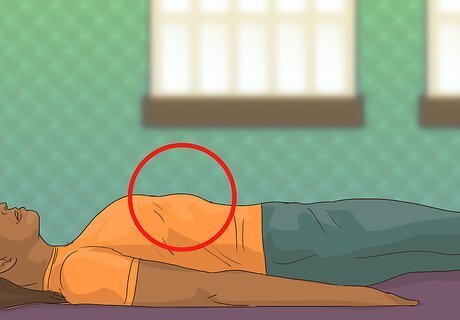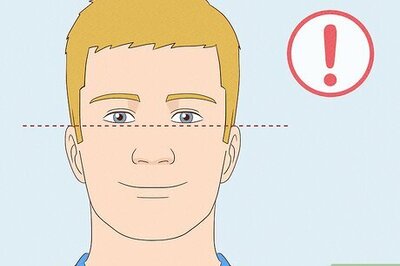
views
Using Confident Body Language

Practice good posture. Hold your head up and keep your chin in when standing and giving a presentation. Imagine you are stretching the top of your head toward the ceiling. Keep your shoulders back and try to keep your earlobes in line with the center of your shoulders. Tuck in your stomach, but be sure not to tilt your pelvis. Your knees should be straight, and the arches of your feet should be supported. Good posture conveys to the audience that you are confident, credible, and sure of your subject. Speaking with proper posture also allows you to project your voice, making your speech clear and assertive.

Move around the space. If you wish to project confidence, don’t be afraid to use the space around you. When you are giving a presentation, try to move around the stage. When people are nervous or apprehensive, they are inclined to close off their movements, stand with their feet together, and hide behind a podium in an attempt to appear small and unnoticeable. This can make you appear inexperienced or anxious. Controlled walking can help you project your expertise and knowledge and can help you feel comfortable in your surroundings.

Step closer to your audience when you make a point. When making a point, make a few steps away from the podium toward the audience. Only move toward the audience when the content of your presentation calls for it. If you are making a point or revealing exciting, unexpected information, that is the time to move. Unnecessary movement can be distracting and can make you appear uneasy. Moving close to the audience helps bridge the gap and creates a sense of authority and confidence. Don’t stand too close to the audience, and don’t move beyond the first row of seats. As you move toward the audience, think about staying there for a period of 30 seconds. When you step in another direction, spend about another 30 seconds there. Think about trying to reach everyone in your audience, and try to make eye contact with several audience members as you move from section to section.

Use hand gestures while giving a presentation. Avoid keeping your arms in a rigid position by your side. Keep your open arms while speaking. Pointing toward the sky can assert an opinion or a fact, while opening your hands can show trustworthiness and inspire audience participation. When coming to the crux of an argument or the summary of your research, point upward with your index finger to assert your authority and appear confident in your conclusion. Don’t cross your arms during a presentation. While this may be a comfortable position, you may be projecting negative cues to your audience. This closed-off position may make you seem inexperienced, uninterested, or nervous.

Smile. A warm, inviting smile will convey to your audience that you are at ease and are comfortable. Your smile will make you appear and sound more pleasant, and you will come off as responsive and composed. Studies have shown that smiling can help reduce anxiety, blood pressure, and your heart rate, all of which will put you at ease while giving your presentation.

Avoid fidgeting. It's okay to feel nervous, but avoid projecting that anxiety if you wish to appear confident. Shuffling back and forth, biting your nails, twirling your hair, and other forms of fidgeting can display signs of boredom or nervousness. Take a some slow, deep breaths when you feel the urge to fidget.

Make eye contact with audience members. Don’t stare at the floor, at your feet, or at your notes. Look up and make eye contact with your audience members. Eye contact is a great way to not only appear confident, but feel confident as well. While giving a presentation, maintain eye contact with an individual for periods of 3 to 5 seconds. Eye contact will demonstrate that you are trustworthy and passionate about the topic, and it will help keep your audience’s attention.
Speaking with Confidence

Project your voice. To appear confident, your voice needs to be heard so your audience can follow your presentation and understand your point. Proper posture will allow you to use the support of your diaphragm, the umbrella-shaped muscle below your stomach, to control the movement of air. When you breathe in, let your stomach expand. This movement is controlled by the diaphragm. Practice using your diaphragm to project your voice. Lie down on your back, and keep your abdominals and stomach relaxed. Keep one hand on your abdomen, and think about moving it up and down as you breathe in and out. Find out in advance if you will be using a microphone for your presentation. This can help you plan ahead and adjust the volume of your voice accordingly.

Vary the speed, pitch, and volume of your voice. In everyday conversation, your pitch, speed, and volume varies when you are chatting with a friend or sharing a story. A monotonous tone can be boring and may convey to the audience that you are unsure or unprepared. Add interest by playing with the dynamics of your speech. Your audience will be more likely to pay attention to your presentation. Try to incorporate these variations in speech while giving your presentation, and pretend as though you are having a conversation with a friend or a colleague. Practice these variations by reading a poem, a play, or another piece of literature aloud.

Pace yourself. When people are nervous, they may be more likely to speak quickly and speed through a presentation. Try to maintain a slow and moderate pace while speaking. This will help the audience understand what you are saying and allow you to communicate your ideas clearly and confidently. Speeding up your speech is acceptable to offer variety in your presentation and may be a useful tool when you are making a particular point, but aim to remain regulated, consistent, and articulate during the majority of your presentation. Stretch out your vowels to slow your speech. Pretend that the vowels are italicized and focus on speaking each one clearly. Practice this technique to ensure that it sounds natural. Break your presentation up into sections. Plan to pause for a moment or two when you reach the end of each section. Allow for one second to pause before moving on to the next point.
Practicing Your Presentation

Study your material. The key to projecting confidence during a presentation is to have a comprehensive knowledge of the topic. When you feel like an expert on a particular subject, you are more likely to project that expertise and knowledge to your listeners. Your audience will be able to tell if you are unprepared or nervous. Be sure to study your subject and your presentation slides thoroughly, and be prepared for any questions the audience may have.

Rehearse it in front of a mirror. Position yourself in front of a mirror and practice giving your presentation. Pretend that you are in front of your peers and colleagues, and try to imagine that you are on the stage or in front of a classroom while speaking. This will allow you to practice your movements, your pace, your hand gestures, and it will remind you to smile during the speech. You will become more familiar with the material and the flow of the information. After several practice runs, you will be more comfortable and confident.

Practicing deep breathing techniques. Take a slow, deep breath in through your nose and hold for ten counts. Exhale slowly through your mouth, tightening your abdominals as you release the breath. Deep breathing can help you focus on your presentation and release any anxiety or tension in your body. Incorporate breathing exercises into your daily routine to help you relax and appear calm, composed, and confident in front of your audience.

















Comments
0 comment